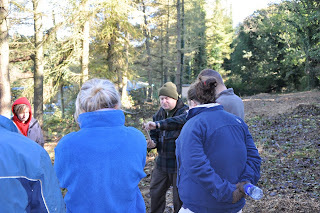I had seen Ray Mears make these and I thought I would give it a go. When I was gifted two days off work due to snow and I couldn’t miss an opportunity!
Firstly, I went and cut a dozen straight willow saplings and picked the best looking ten. It was like a winter wonderland and I had a friend in the form of a curious little robin to keep me company. I cut them with a folding saw at each end to the same thickness and put them in the car.
Back home, I cut the willow rods to be slightly longer than I am tall (6ft) and stripped the bark. I then pointed the rear ends to ease travel. Then I tied them at one end using a clove hitch and found the balance point. This is where the ball of the foot goes.
I had a couple of pieces of hazel, which I split to use as cross pieces. I lashed the cross pieces on using twine – one at the balance point and one at the heel. This was probably the longest job! Interestingly, another little robin came up to see what I was doing!
I loosely tied the rear ends together and bent up the front ends like skis. This needed some cord slightly stronger than the twine as they are under more tension.
I used thin polypropylene twine for the lashing, which is ‘slippy’ and doesn’t hold knots well – but I was improvising. I expect that as the willow seasons over the next while the lashing might loosen. I will probably rebind them all with better stuff at some point.
I tried using some leftover elasticated upholstery webbing as bindings that I had used for making canoe seats, but they stretched too much. I bought a bit of 25mm polypropylene webbing and that worked really well. Tying the bindings on so that they didn’t loosen took a bit of jiggling but finally got it.
I took them out in a local field with a good depth of snow and they worked really well. It was an interesting project – not sure if I would have enough cordage in a survival situation to make them – but you never know.
Pictures and write up by Stuart staples.



















































